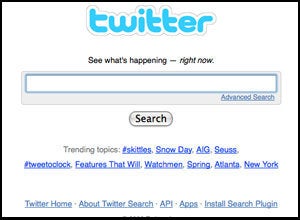
I love technology. I've been a BlackBerry person since 2002, a Mac person since the '80s. Back in the early '90s, when I was new to the Internet, I once spent 26 hours straight on it. Never did find the end. I've blogged while walking down the street talking to a candidate. I use a wireless network of laptops, with one or more frequently playing an international news channel.
But early adoption can go down wrong paths. I spent weeks trying to teach a Newton handheld to read my handwriting. The $5,000 I spent for the souped-up version of the PowerBook that saved the planet in Independence Day was not the wisest investment, though mine never caught fire. And there was ISDN, an early high-speed Internet connection. Uh, no, give me back my dial-up!
Which brings us to Twitter. I get news alerts and sitreps, e-mails, memos, and press releases, day and night. I write at any hour. But do I want tiny "tweets," bitelets of what is arguably information, frequently trivial and not infrequently wrong, demanding my attention at any moment? Do I want to send such stuff out?
We live in the midst of a media cacophony.
It's a time marked by inundation, fragmentation, and an ADD culture.
Twitter drives all three of those trends.
For those who haven't checked it out, Twitter is a little like text messaging, very brief, near instant messages faster than e-mail. I got into that years ago, after some resistance, at the behest of girlfriends. It's fun, within the context of a back-and-forth. Though it can certainly go on and on.
But aside from the extreme brevity, Twitter is not like that. Except for the on and on part.
At 140 characters per message, tweets are even shorter than texts. And they lack the context.
And if there is one thing our media culture has already been lacking, it's context. Spend too much time watching American cable news, where you can literally see faddish and frequently groundless political views become a faux consensus in a matter of hours as folks rather hysterically talk themselves into a viewpoint that is totally at odds with political reality outside the echo chamber, and that's already clear.
Then add something like Twitter, and the hysteria can reach a fever pitch, with commentators, conventional and unconventional alike, tweeting feverishly away into the ether, hoping their info-bleeps capture a moment's attention.
One part of the problem, of course, is that the format is simply too short. I value the blizzard of information I'm signed up for, distracting and tiring as it can be, because it comes in usually intelligible form. Which is to say, at least a paragraph.
Perhaps when the technology that follows after Twitter allows more space for explanation of what the frak it is one is so frantically trying to say, it will be truly useful.
Kind of like what followed a few years after the Newton. But in the meantime, the personal digital assistant concept was discredited.
Another part of the problem is what, for lack of a better phrase, I'll call the inane factor.
Facebook is something I'm on but have mostly ignored til lately, mainly because of how busy the campaign season was. But it's intriguing, because of its rich media environment and the ability to link at one's own pace. When I started checking it out more, a friend warned: "Get ready for the inanity."
A Facebook status update is like a tweet. Except you can actually say more on Facebook. As it happens, much of what people choose to say -- about their plane flights, their desires for dinner, and so on -- is less than fascinating.
But on Facebook, at least, one can scroll right past a status update, or never even look at it.
Tweets are more demanding of attention.
And if someone I'm not in a pretty close relationship with -- or am at least having a conversation with -- demands to tell me about their desire for a baked potato and a viewing of The Singing Nun, I'm not too happy.
All this reminds me of the old Max Headroom TV series from the 1980s.
Because the media culture in the Max Headroom universe of Britain and America was waterlogged with a cacophony of messages, the ad mavens created the "blipvert." A 5-second condensed TV ad so compelling and so swift that the viewer had no opportunity to switch to another channel with the remote control.
But they had one extremely unfortunate side effect.
Blipverts caused the nervous systems of "particularly lazy, petulant viewers," as an ad maven called them, to overload and their heads to explode.
Overlay the current version of Twitter on top of our increasingly hysterical media cacophony, and there we are. Metaphorically speaking, naturally ...